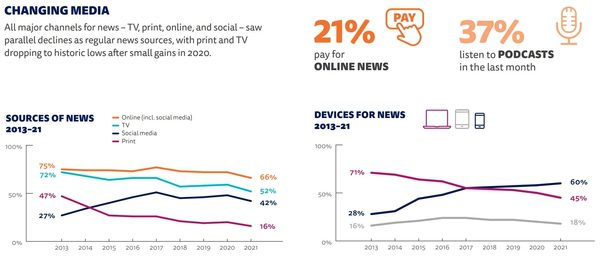 What’s past is prologue. The politically driven news cycle shows no signs of letting up, while health journalists/experts look to remain in demand as misinformation campaigns prolong. It also looks like newsletter launches (which seem to have taken the place of beat articles) are outpacing new podcasts.
What’s past is prologue. The politically driven news cycle shows no signs of letting up, while health journalists/experts look to remain in demand as misinformation campaigns prolong. It also looks like newsletter launches (which seem to have taken the place of beat articles) are outpacing new podcasts.
The public’s interaction with news media was guaranteed to change in a year as unprecedented as 2020. A Pew Research Center report illustrates that with six key takeaways:
- For newspapers, 2020 was the first year that circulation brought in more revenue than advertising.
- Audience increased at major cable news channels, with Fox News seeing a 61% increase in viewership, CNN seeing a 72% increase in viewership, and MSNBC seeing a 28% increase in viewership.
- Total political ad revenue at local news stations amounted to $2 billion in 2020, more than in any previous election year.
- A larger share of the revenue at public broadcasting corporations was sourced from individual donors. For instance, from 2014 to 2020, the percentage of nonpublic funding from individuals rose to 24% from 3%.
- News outlets in 2020 drew more revenue from digital advertising than from nondigital, a trend that began in 2019.
- While podcast listenership increased in 2020, terrestrial radio listenership, according to data from Nielsen Media Research, declined to 83% from 89%. A lack of driving during the Covid-19 shutdowns was likely a key factor that drove this decrease.
2021 has also brought massive changes in the media industry as specific needs continue to emerge. The digitization of newsrooms has continued since 2020, with workflows changing to further adapt to the continuation of remote work. As Pew Research Center finds, since 2008, newsroom employment has plummeted at U.S. newspapers while increasing in the digital publishing sector. Though the decline has stabilized since 2014.
Further, health reporters and medical experts are in high-demand to provide accurate information as the pandemic evolves. Newsrooms are also focusing on building up their fact-checking capabilities (see the AP’s hire of Julie Pace) in order to combat vaccine misinformation. There is a move towards paid content, and retaining subscribers after they are confronted with paywalls will be key.
A Reuters Institute Digital News Report notes that television news has continued to perform well in 2021, but print news is still on the decline as the pandemic continues to shift people towards digital tools. Reuters finds (Pages 28/29) podcasts are of particular interest to publishers because they attract younger and more affluent users that are highly sought by advertisers – and are potentially the next generation of subscribers.
 Newsletter subscriptions have also continued to increase in 2021. On the other side, the Reuters data also suggests a decline in engagement with the news overall, partially due to Gen-Z’s reliance on social media as an information-gathering and storytelling tool.
Newsletter subscriptions have also continued to increase in 2021. On the other side, the Reuters data also suggests a decline in engagement with the news overall, partially due to Gen-Z’s reliance on social media as an information-gathering and storytelling tool.
Final thought: Elections are right around the corner. If the hoopla around California Gov. Gavin Newsom‘s recall win is foreshadowing, newsrooms around the U.S. will need to prepare for a ride.
Some dates to note: 2022 State Primary Election Dates and Filing Deadlines
— Baz Hiralal contributed to this report. —






